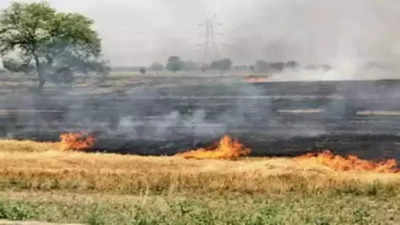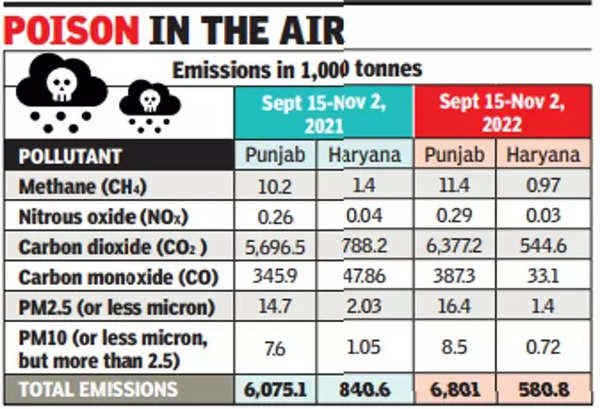- News
- City News
- delhi News
- Punjab farm fires: Particulate matter, greenhouse gases emissions up this year
Trending
This story is from November 4, 2022
Punjab farm fires: Particulate matter, greenhouse gases emissions up this year
Stubble burning in Punjab caused emissions of 6,800.97 thousand tonnes of greenhouse gases and particulate matter between September 15 and November 2 this year as against 6,075.11 thousand tonnes of pollutants released last year during the same period, according to Indian Agricultural Research Institute (IARI).

Image used for representational purpose
NEW DELHI: Stubble burning in Punjab caused emissions of 6,800.97 thousand tonnes of greenhouse gases and particulate matter between September 15 and November 2 this year as against 6,075.11 thousand tonnes of pollutants released last year during the same period, according to Indian Agricultural Research Institute (IARI).
Experts said Punjab recorded more fire counts and the intensity of burning was almost the same as last year.However, there was no data on how much pollutants were transported to Delhi as it depends on wind direction and speed.

The Consortium for Research on Agroecosystem Monitoring and Modelling from Space (Creams) at IARI estimated the greenhouse gas emissions, like methane (CH4), nitrous oxide (NOx), carbon dioxide (CO2) and carbon monoxide (CO) and pollutants, including PM2.5 and PM10, using satellite remote sensing of paddy fire events and fire intensity.
IARI’s data showed that between September 15 and November 2, PM2.5 from farm fires in Punjab was 16.4 thousand tonnes in 2022 against 14.7 thousand tonnes in 2021. During the same period, PM10 was 8.46 thousand tonnes this year against 7.6 thousand tonnes.
Satellites detected 21,480 farm fires in Punjab from September 15 to November 2 this year against 18,066 last year.
While Punjab saw a rise in the quantity of greenhouse gases and pollutants, Haryana witnessed a decrease this time. According to IARI, emission from stubble burning between September 15 and November 2 reduced from 840.6 thousand tonnes in 2021 to 580.8 thousand tonnes in 2022.
“Compared with last year, Haryana has so far recorded less stubble burning counts and even the intensity of fire was low,” said Sehgal. From September 15 to November 2, farm fires in Haryana were 2,249 this year as against 3,241 last year.
Though IARI estimates the emissions emitted from burning of paddy residue, no study has been done to calculate the volume of emissions transported to Delhi. “If transport-level wind speed is slow, it will not be able to reach Delhi,” said an official.
Experts said Punjab recorded more fire counts and the intensity of burning was almost the same as last year.However, there was no data on how much pollutants were transported to Delhi as it depends on wind direction and speed.

The Consortium for Research on Agroecosystem Monitoring and Modelling from Space (Creams) at IARI estimated the greenhouse gas emissions, like methane (CH4), nitrous oxide (NOx), carbon dioxide (CO2) and carbon monoxide (CO) and pollutants, including PM2.5 and PM10, using satellite remote sensing of paddy fire events and fire intensity.
“Emissions depend on fire counts and intensity. If the fire is intense, it means more volume of stubble is being burnt. Punjab saw a rise in greenhouse gas and pollutants as there were more fire counts this year. However, the intensity of burning was almost similar to last year,” said professor Vinay Sehgal, principal scientist and in-charge of Creams laboratory. He added that greenhouse gases impact the climate, while PM2.5 and PM10 affect human health.
IARI’s data showed that between September 15 and November 2, PM2.5 from farm fires in Punjab was 16.4 thousand tonnes in 2022 against 14.7 thousand tonnes in 2021. During the same period, PM10 was 8.46 thousand tonnes this year against 7.6 thousand tonnes.
Satellites detected 21,480 farm fires in Punjab from September 15 to November 2 this year against 18,066 last year.
While Punjab saw a rise in the quantity of greenhouse gases and pollutants, Haryana witnessed a decrease this time. According to IARI, emission from stubble burning between September 15 and November 2 reduced from 840.6 thousand tonnes in 2021 to 580.8 thousand tonnes in 2022.
“Compared with last year, Haryana has so far recorded less stubble burning counts and even the intensity of fire was low,” said Sehgal. From September 15 to November 2, farm fires in Haryana were 2,249 this year as against 3,241 last year.
Though IARI estimates the emissions emitted from burning of paddy residue, no study has been done to calculate the volume of emissions transported to Delhi. “If transport-level wind speed is slow, it will not be able to reach Delhi,” said an official.
End of Article
FOLLOW US ON SOCIAL MEDIA










